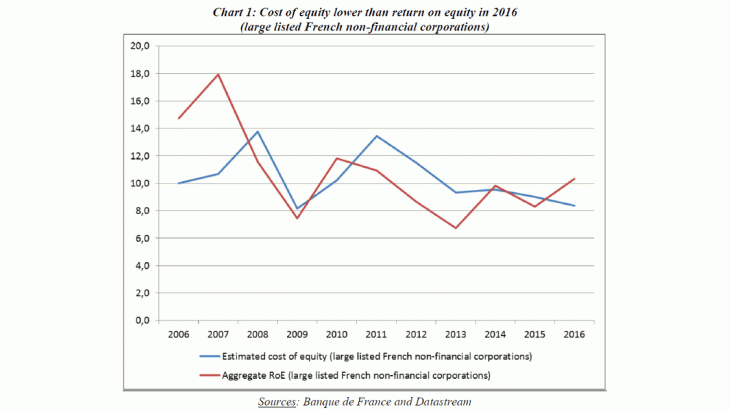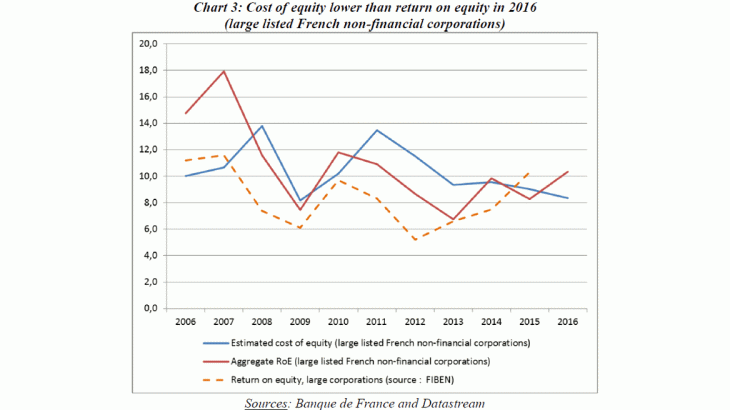However, the level of the CoE at mid-2017 is clearly lower than the peaks recorded during the financial crisis of 2007-2009 and the sovereign debt crisis in the euro area in 2011-2013. These had prompted several observers to issue warnings about an excessive level of cost of equity in France and in Europe following the crisis (see, for example, the Villeroy de Galhau report, 2015). The current level also remains below its average over the 2006-2017 period (10.5%). This average corresponds more or less to the level of the CoE in 2006, before the subprime crisis. In addition, our estimate of the CoE is within the upper range of estimates for this indicator. In fact, it is higher because share buybacks are taken into account, which can represent a significant share of the compensation of large company shareholders. Without these buybacks, our estimate of the equity risk premium in Europe would on average be lower by two percentage points over the last decade. However, this gap narrowed in 2017 and is now below 1%. This reflects a slowdown in buybacks in a context of relatively high stock prices.
The real CoE is also below its long-term average at mid-2017
While the moderate level of the nominal COE is good news, the decision to invest depends, in theory, on the real cost of capital, i.e. the nominal cost adjusted for changes in expected prices over the financing period of the investment. Chart 2 also shows a measure of the real cost of equity for large non-financial corporations. We deflate the nominal CoE by the current total inflation, excluding energy and unprocessed food (known as supercore inflation), which is less volatile than headline inflation and therefore more likely to represent a short to medium term expectation of inflation. According to this measure, at 8.6% at the end of June 2017, companies’ real CoE remains well below its long-term average (9.3%), despite a slight increase since the start of the year.
Increased profitability of large companies
Is the cost of equity faced by large French companies too high? To answer this question it is necessary to compare this cost with the profitability of business projects for shareholders.
The internal rate of return for shareholders of investment projects planned by a large firm is hardly accessible for an outside observer. Nevertheless, the company’s return on equity over the last financial year provides a useful approximation. We therefore calculate a measure of the aggregate RoE for the same sample of large listed French non-financial corporations on the basis of the annual net income data and the amounts of book value equity collected by Datastream.
Chart 1 at the top of this post, in annual frequency, compares the cost of equity with this measure of RoE of large French non-financial corporations listed in the Eurostoxx. At end-2016, the RoE exceeded the CoE (10% vs. 8.4%). According to our calculations, the RoE of large non-financial corporations has increased since 2013. This is consistent with the rise in the margin rates of non-financial corporations observed at the macroeconomic level over the same period (32% in 2016, compared with 30% in 2013 according to INSEE). We also present (see Chart 3 below, dotted line) the return on equity of all large non-financial corporations, calculated in annual frequency by the Banque de France using FIBEN balance sheet data. In spite of methodological differences between these sources, the return on equity of large non-financial corporations also appears to be on an upward trend since 2012, reaching 10.3% in 2015 (last available year), i.e. more than one percentage point above our CoE estimate at that time. It should be noted here that the situation is very different for large banks, with a significantly higher estimated CoE (about 14%) and a much lower RoE (around 6.5% in 2016, see this ACPR press release) than what we get for non-financial corporations.


